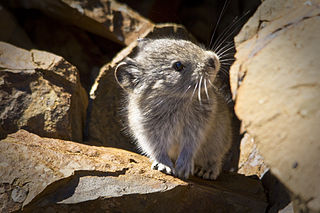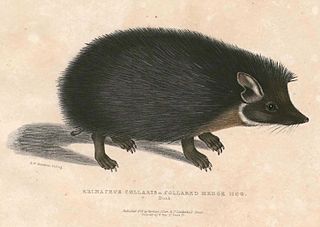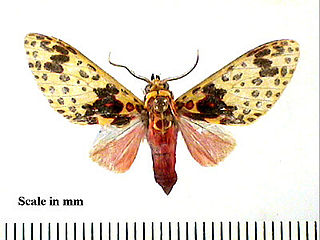
The alpine accentor is a small passerine bird in the family Prunellidae.

The common collared lizard, also commonly called eastern collared lizard, Oklahoma collared lizard, yellow-headed collared lizard, and collared lizard, is a North American species of lizard in the family Crotaphytidae. The common name "collared lizard" comes from the lizard's distinct coloration, which includes bands of black around the neck and shoulders that look like a collar. Males can be very colorful, with blue green bodies, yellow stripes on the tail and back, and yellow orange throats. There are five recognized subspecies.

The collared pika is a species of mammal in the pika family, Ochotonidae, and part of the order Lagomorpha, which comprises rabbits, hares, and pikas. It is a small alpine lagomorph that lives in boulder fields of central and southern Alaska (U.S.), and in parts of Canada, including northern British Columbia, Yukon, and western parts of the Northwest Territories. It is closely related to the American pika, but it is a monotypic form containing no recognized subspecies. It is asocial, does not hibernate, and spends a large part of its time in the summer collecting vegetation that is stored under rocks ("haypiles") as a supply of food for the winter. Some individuals have been observed collecting and consuming dead birds as sources of fat and protein. Thousands of trips are made during July and August to collect vegetation for winter.

The Indian long-eared hedgehog is a small species of mammal native to northern India and Pakistan. It is insectivorous and nocturnal.
Mannophryne collaris is a species of frog in the family Aromobatidae. It is endemic to Venezuela where it is found in the Andes in the Mérida state. Its natural habitat is seasonal (semi-deciduous) montane forest at elevations of 200–1,800 m (660–5,910 ft) asl. While a locally abundant species, it is threatened by habitat loss.

Amaxia is a genus of moths in the family Erebidae erected by Francis Walker in 1855. The type species of the genus is Amaxia pardalisWalker, 1855.
Amaxia inopinata is a moth of the family Erebidae. It was described by Hervé de Toulgoët in 1989. It is found in Ecuador.
Amaxia apyga is a moth of the family Erebidae. It was described by George Hampson in 1901. It is found in Costa Rica.

Amaxia chaon is a moth of the family Erebidae. It was described by Herbert Druce in 1883. It is found in Ecuador, Suriname and French Guiana.
Amaxia pardalis is a moth of the family Erebidae. It was described by Francis Walker in 1855 and is the type species of the genus Amaxia. It is found in Brazil, Suriname, Costa Rica and Mexico.
Amaxia egaensis is a moth of the family Erebidae. It was described by Seitz in 1921. It is found in Brazil.
Amaxia flavicollis is a moth of the subfamily Arctiinae. It was described by Rothschild in 1909. It is found in French Guiana, the upper Amazon basin, Venezuela, Ecuador and Brazil.
Amaxia hebe is a moth of the family Erebidae. It was described by William Schaus in 1892. It is found in Brazil.
Amaxia lepida is a moth of the family Erebidae. It was described by William Schaus in 1912. It is found in Costa Rica.
Amaxia perapyga is a moth of the family Erebidae. It was described by Walter Rothschild in 1922. It is found in Brazil.
Amaxia pseudodyuna is a moth of the family Erebidae. It was described by Walter Rothschild in 1922. It is found in Brazil.
Amaxia reticulata is a moth of the family Erebidae. It was described by Walter Rothschild in 1909. It is found in French Guiana, Suriname and the Brazilian state of Amazonas.
Amaxia theon is a moth of the family Erebidae. It was described by Herbert Druce in 1900. It is found in French Guiana, Venezuela, Ecuador, Peru and Bolivia.
Amaxia violacea is a moth of the family Erebidae. It was described by Reich in 1933. It is found in Peru.
Neohydatothrips is a genus of thrips in the family Thripidae. There are at least 30 described species in Neohydatothrips.





